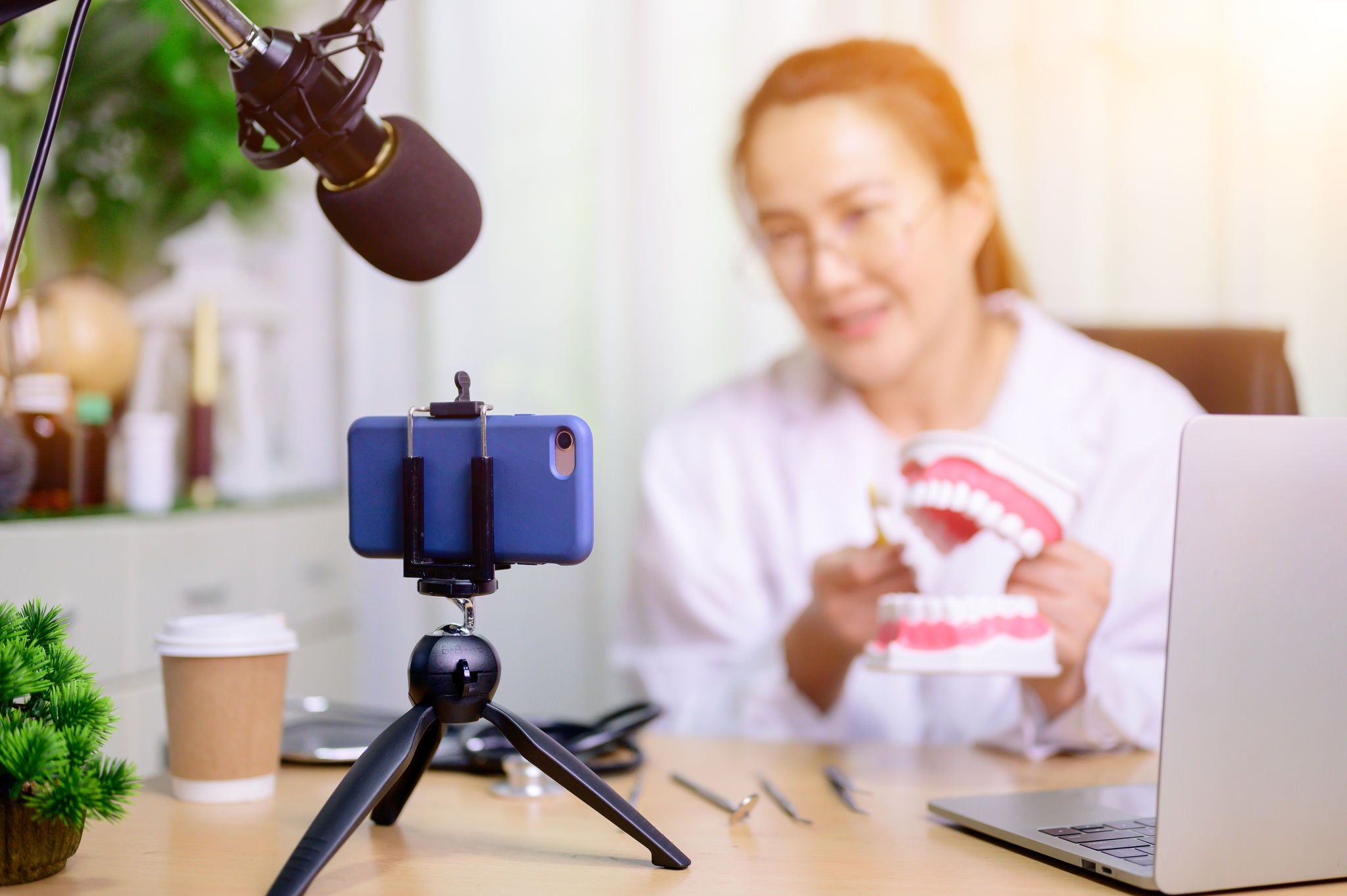
How Can Dentists Use Social Media to Communicate and Build Stronger Community?
In today’s world, social media cannot be ignored. These online networks have become mainstays for communications among friends, families, peers, colleagues, brands, customers, and – yes – patients and providers.

The onset of COVID-19 and social distancing has only accelerated adoption of these digital channels. As a dental professional, social media presents an opportunity to build community and improve engagement – not only with your patients but with fellow professionals as well.
Of course, those in the healthcare space have extra factors to consider, compared to a brand account or someone’s personal account. Dental care, specifically, has its own set of recommended best practices and pitfalls to avoid.
Read on and we’ll explore what to do as a dentist on social media, and what not to do. But first, let’s explore why this might be worth pursuing.
Social media for dentists: value and benefits
At last check, more than half the world’s population – some 4.6 billion people – use social media. Adoption is especially prevalent among younger generations of digital natives, pointing to continued growth.
From a pure marketing standpoint, it’s easy to see how being active on social media can help your practice gain more awareness and attract new patients. But the advantages of using social media as a dental professional go beyond business growth benefits.
With easy, convenient, and multimedia-driven communication, these channels have a lot of potential for helping dentists deliver better care and build stronger relationships.
One of the biggest advantages of being present on social media, in terms of patient care, is the consistent visibility. Many social media users log into their accounts every day – even multiple times per day. Given the importance of adhering to a regular oral care routine at home, this constant touchpoint with patients can be a great way to reinforce good habits and present new tips, ideas, and products to help them succeed.

Social media can also help the professionals at your practice become more authentic and relatable in the eyes of your patients. Instead of seeing the dentist, periodontist, and hygienists only a couple of times per year in a clinical setting, patients will have the ability to see and engage with them more regularly, while seeing their genuine voices and personalities expressed through these feeds.
In the new age of dentistry and healthcare, social media can be a wonderful asset. But it needs to be used carefully.
Dental social media posts: best practices and pitfalls
Evolving technologies often feel scary, and the permanence of the World Wide Web – the internet never forgets – can make this space an especially intimidating one. But don’t let these reservations hold you back from enjoying the advantages covered above.
With a few guidelines in place, you can proceed confidently with a social media presence that projects your expertise, quality, and commitment to patient success.
- DO
- DON'T
Know what purpose you’re trying to achieve with the social media account.
Is your goal on social media to educate and engage with your patients, or to connect and share knowledge with your peers in the industry?
A recent issue of EFP’s Perio Life suggested that dentists might consider creating separate accounts for these distinct purposes.
“When you are sharing content specifically for your peers – such as clinical cases and new advances in research – you can create a profile with your own professional name, where your main followers will come from your professional network and from industry,” wrote EFP’s Bruno De Carvalho and Cândice Gasperin. “This will allow you to share the quality of your clinical cases, the research you have been publishing, and will help to improve the referral of patients from your colleagues.”
“When your audience is patients, the profile should be your periodontal or dental practice, which will allow you to share simplified ‘before and after’ clinical cases, the practice environment, and what happens backstage.”
Knowing your objectives on social media will also dictate which platforms you show up on. If you’re more interested in developing thought leadership and advancing your professional reputation, LinkedIn might be a good place to become active. If you’re interested in creating visual “how-to” content for patients, Instagram or TikTok might be strong fits.
Be authentic and engaging with social media connections and followers.
Social media is most effective when it’s a two-way communication channel. If your followers see that you’re actually engaging and interacting on these platforms, as opposed to simply broadcasting messages, they’ll more likely find them valuable and your practice will be more successful in building online community.
This doesn’t mean you need to be available at all times to immediately respond. But try to reply to comments and messages when you’re able. When posting content, add a little personality and include the name of the person speaking. (“Hi, this is Emily, your friendly dental hygienist with a great tip for brushing those hard-to-reach spots.”) This way, when patients do come in for a real visit, they will feel a deeper sense of familiarity and rapport.
Take a moment to pause and reflect before posting on social media.
“Once uploaded onto a social media platform,” wrote Sharma, “content is in the public domain instantaneously and with the extensive use of social media globally you can be confident that someone would have seen that post in the first few seconds. This, of course, does not allow for any mistakes.
“So, if in hindsight you realise you should not have posted what you did moments ago and subsequently delete it, be mindful that it is still retained in the cloud’s virtual memory or it may have been reposted by any of your contacts or followers. Additionally, be vigilant of who you follow or ‘friend’ as this may impact you negatively. Ensure you are the only one that can post content on your social media, in turn taking ownership of all your content.”
The power and permanence of social media and the Web should never be underestimated. As such, one of Sharma’s most pointed pieces of advice for dentists on social media is to simply reflect.
“Before posting any content, take a step back and see how it may be perceived by a member of the public. At face value this seems to be an obvious step. However, a quick search online reveals some very questionable content by professionals around the world. Do not view your social media profile as independent from you – in fact, it is the ‘you’ that the world will know!”
Share any sensitive information or patient details.
This is easily the No. 1 most important thing to be vigilant about as a dentist or dental practice on social media. The General Dental Council has a specific guideline pertaining to this matter in its Standards for the Dental Team documentation:
Standard 4.2.3: You must not post any information or comments about patients on social networking or blogging sites. If you use professional social media to discuss anonymised cases for the purpose of discussing best practice you must be careful that the patient or patients cannot be identified.
Stress the importance of patient privacy to anyone who may play a role in managing your social media accounts. It is not advisable to openly reference any specific patients or their treatments, but if doing so, make sure to remove any possibly identifying details.
Different countries and regions will have their own specific rules and regulations pertaining to patient data, so be sure to learn and adhere to them.
Behave in ways that don’t reflect well on yourself, your practice, or your profession.
If you’ve spent any amount of time on social media, you’re surely aware it can sometimes become an emotional and contentious place. Some people use their accounts to vent after a bad day; others might use these networks to share personal views, life experiences, and more.
With this in mind, let’s look at another standard from the GDC guidebook:
- Standard 9.1.3: You should not publish anything that could affect patients’ and the public’s confidence in you, or the dental profession, in any public media, unless this is done as part of raising a concern.
- Public media includes social networking sites, blogs and other social media. In particular, you must not make personal, inaccurate or derogatory comments about patients or colleagues.
As Priya Sharma shared at Dental Nursing: “Act responsibly on social media as you would in ‘real life’. Do not post any images or content that puts your professional reputation at risk or questions the public confidence in dentistry. This would include inappropriate personal views, photos and/or videos. Every time you use the internet you leave a digital footprint. There is traceability of all your online activity.”
That final point brings us to our final recommendation, which relates to something mentioned earlier: the internet never forgets.

